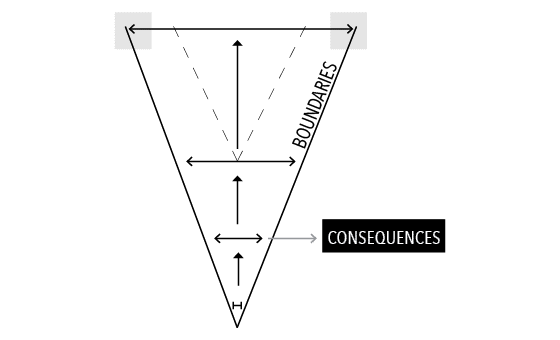Boundaries, Consequences, & Self-Governance
The Freedom V:
Communicating boundaries and consequences enhances freedom, unleashes creativity, and increases efficiency.
The Freedom V is used to teach the value of choices and encourage self-governance. This tool communicates the reality of boundaries and consequences.

What is self-governance?
A self-governing person takes ownership of their ability to choose. They decide which of the options around them best furthers their mission. Self-governance is the ability to make decisions and set boundaries without external dependence.
Importantly, this is a skill that can be learned. By creating intentional structures within our organizations, clearly communicating what is honorable and what is shameful, and reinforcing these systems, we can help participants understand the reality of boundaries and consequences, and usher all members toward a life of good stewardship.
The Freedom V is a HERE tool. It is a mental model for the guardrails that keep us on the PATH toward our transcendent THERE.
Why does self-governance matter?
Self-governance is more effective:
– People work harder when they’re passionate about what they’re doing. When they feel like key contributors, they get more done. Leaders motivate through vision and values, not fear or duty.
– Each participant co-owns the organization’s mission.
– Self-governance focuses on truth and reality. Thus, it reduces the time we waste trying to avoid consequences, making excuses, and shifting blame.
Structure demands behavior
By establishing and communicating boundaries and consequences (which make the walls of the V), organizations communicate what is honorable and what is shameful.
Everything inside of the V is permissible. But everything outside of the boundaries is off-limits and will result in undesirable consequences.
When individuals violate established boundaries, leaders help establish the reality of the situation. Leaders help discern proper placing on The Freedom V. Sometimes, a person can be “moved down” the Freedom V, effectively tightening their boundaries. However, if a person shows great aptitude, they can be “moved up” the Freedom V, widening their boundaries and expanding the invitation into self-governance.
Why do we have to have consequences at all?
Consequences are developmental and exist to teach individuals how to live within the established boundaries. They are not strictly punitive. In the long term, consequences are meant to teach members the value of creating their own boundaries within the structures provided. As the skill of self-governance develops, individuals become less and less dependent on external boundaries, learning to set and uphold boundaries for themselves.
Characteristics in the bottom of the V
- Very narrow boundaries. Minimal freedom. High oversight.
- Leadership Styles typically used: Directive, Transactional
- Types of Influence typically used: Positional, Coercive, Reward
- Examples:
- A toddler who doesn’t yet understand how the world works
- A new employee learning the ropes
- An existing employee moving into a new position within the organization/or moving under a new manager
Characteristics in the middle of the V
- Narrow-wide boundaries. Moderate level of freedom, moderate level of oversight
- Leadership Styles typically used: Transactional, Participative, Delegative
- Types of Influence typically used: Coercive, Reward, Expert, Referent
- Examples:
- An employee who has been on the job for 6-12 months
- A teenager going into high school
- An existing employee who has recently been moved down the Freedom V
Characteristics at the top of the V
- Wide boundaries. High level of freedom, minimal oversight
- Leadership Styles typically used: Mainly Transformational, sometimes Delegative
- Types of Influence typically used: Expert, Referent
- Examples:
- A child going off to college
- An employee who has demonstrated high levels of proficiency, an ability to self govern, and commitment to the mission


